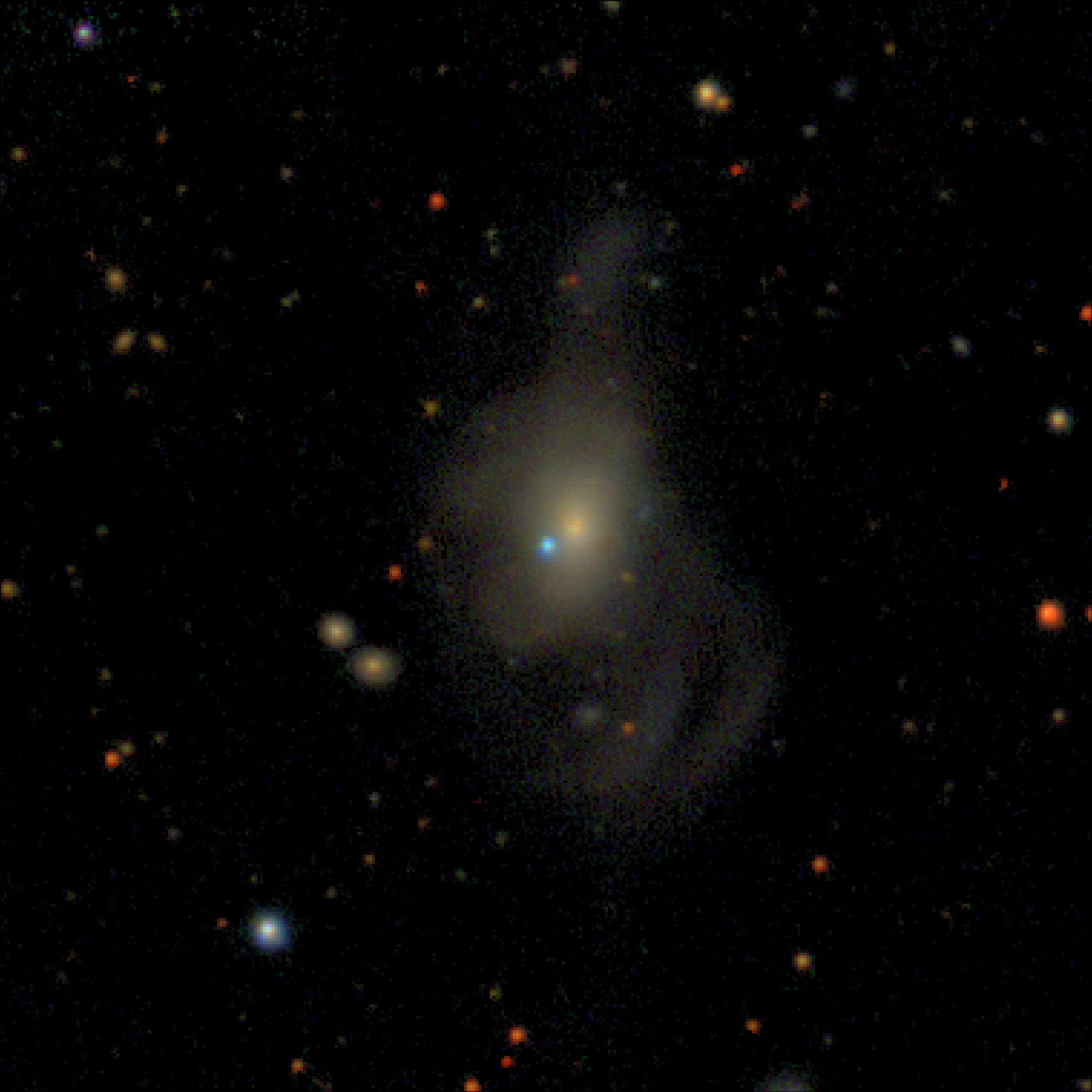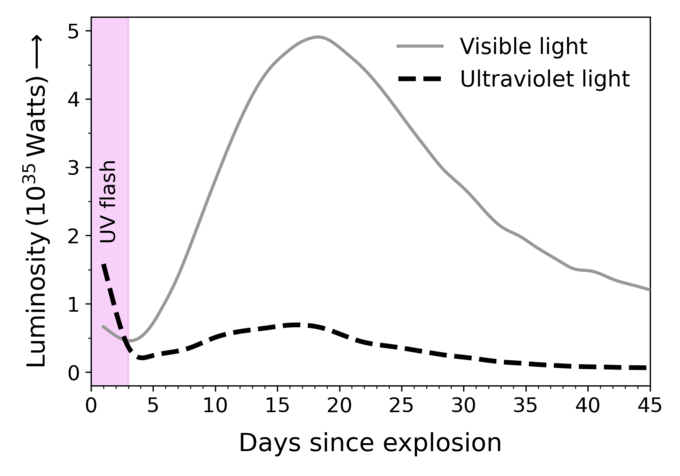
Spectacular Ultraviolet Flash May Finally Explain How White Dwarfs Explode

Event also could give insight into dark energy and the creation of iron
- White dwarf explosion caused extremely rare burst of ultraviolet (UV) light
- This is just the second time a UV flash accompanied a type Ia supernova
- White dwarfs are cool objects; UV light requires something incredibly hot
- Researchers will have a better understanding of how white dwarfs explode as they continue to watch the event throughout the year
Pasadena, CA — For just the second time ever, astrophysicists have spotted a spectacular flash of ultraviolet (UV) light accompanying a white dwarf explosion.
An extremely rare type of supernova, the event is poised to offer insights into several long-standing mysteries, including what causes white dwarfs to explode, how dark energy accelerates the cosmos and how the universe creates heavy metals, such as iron.
“The UV flash is telling us something very specific about how this white dwarf exploded,” said Northwestern University astrophysicist Adam Miller, who led the research. “As time passes, the exploded material moves farther away from the source. As that material thins, we can see deeper and deeper. After a year, the material will be so thin that we will see all the way into the center of the explosion.”
At that point, Miller said, his team will know more about how this white dwarf — and all white dwarfs, which are dense remnants of dead stars — explode.
The paper will be published on July 23 in The Astrophysical Journal. The news release can also be found here.
Common event with a rare twist
Using the Zwicky Transient Facility, funded by the National Science Foundation (NSF) and located at Palomar Observatory near San Diego, researchers first spotted the peculiar supernova in December 2019 — just a day after it exploded. The event, dubbed SN2019yvq, occurred in a relatively nearby galaxy located 140 million light-years from Earth, very close to tail of the dragon-shaped Draco constellation.
“Catching supernova as they are being born was a major driver for the Zwicky Transient Facility. It is a challenging goal but when astronomers are able to do it, like the recent discovery of SN 2019yvq, it can reveal new insight into supernovae physics and their progenitor systems,” said Caltech Professor Shri Kulkarni, the principal investigator of the Zwicky Transient Facility.
Within hours, astrophysicists used NASA’s Neil Gehrels Swift Observatory to study the phenomenon in ultraviolet and X-ray wavelengths. They immediately classified SN2019yvq as a type Ia (pronounced “one-A”) supernova, a fairly frequent event that occurs when a white dwarf explodes.
“These are some of the most common explosions in the universe,” Miller said. “But what’s special is this UV flash. Astronomers have searched for this for years and never found it. To our knowledge, this is actually only the second time a UV flash has been seen with a type Ia supernova.”
"The first such case is iPTF14atg. It was discovered by the intermediate Palomar Transient Factory, the predecessor of the Zwicky Transient Facility, " said Caltech graduate student Yuhan Yao, a co-author on this paper. " SN 2019yvq exhibits a much higher velocity than iPTF14atg, demonstrating that this phenomenon is actually more common than we originally believed."
Heated mystery
The rare flash, which lasted for a couple days, indicates that something inside or nearby the white dwarf was incredibly hot. Because white dwarfs become cooler and cooler as they age, the influx of heat puzzled astronomers.
“The simplest way to create UV light is to have something that’s very, very hot,” Miller said. “We need something that is much hotter than our sun — a factor of three or four times hotter. Most supernovae are not that hot, so you don’t get the very intense UV radiation. Something unusual happened with this supernova to create a very hot phenomenon.”
Miller and his team believe this is an important clue to understanding why white dwarfs explode, which has been a long-standing mystery in the field. Currently, there are multiple competing hypotheses. Miller is particularly interested in exploring four different hypotheses, which match his team’s data analysis from SN2019yvq.“The simplest way to create UV light is to have something that’s very, very hot,” Miller said. “We need something that is much hotter than our sun — a factor of three or four times hotter. Most supernovae are not that hot, so you don’t get the very intense UV radiation. Something unusual happened with this supernova to create a very hot phenomenon.”

Evolution of the ultraviolet and visible light emitted from SN2019yvq. Most Type Ia SNe emit far more light in the visible region of the electromagnetic spectrum than in the ultraviolet. As shown here, SN 2019yvq exhibited a spectacular ultraviolet flash just after it exploded. Credit: A. A. Miller/Northwestern University
Miller and his team believe this is an important clue to understanding why white dwarfs explode, which has been a long-standing mystery in the field. Currently, there are multiple competing hypotheses. Miller is particularly interested in exploring four different hypotheses, which match his team's data analysis from SN 2019yvq.
Potential scenarios that could cause a white dwarf to explode with a UV flash are:
- A white dwarf consumes its companion star and becomes so large and unstable that it explodes. The white dwarf’s and companion star’s materials collide, causing a flash of UV emission;
- Extremely hot radioactive material in the white dwarf’s core mixes with its outer layers, causing the outer shell to reach higher temperatures than usual;
- An outer layer of helium ignites carbon within the white dwarf, causing an extremely hot double explosion and a UV flash;
- Two white dwarfs merge, triggering an explosion with colliding ejecta that emit UV radiation.
“Within a year,” Miller said, “we’ll be able to figure out which one of these four is the most likely explanation.”
Earth-shattering insights
Once the researchers know what caused the explosion, they will apply those findings to learn more about planet formation and dark energy.
Because most of the iron in the universe is created by type Ia supernovae, better understanding this phenomenon could tell us more about our own planet. Iron from exploded stars, for example, formed the core of all rocky planets, including Earth.
“If you want to understand how the Earth was formed, you need to understand where iron came from and how much iron was needed,” Miller said. “Understanding the ways in which a white dwarf explodes gives us a more precise understanding of how iron is created and distributed throughout the universe.”
Illuminating dark energy
White dwarfs already play an enormous role in physicists’ current understanding of dark energy as well. Physicists predict that white dwarfs all have the same brightness when they explode. So type Ia supernovae are considered “standard candles,” allowing astronomers to calculate exactly how far the explosions lie from Earth. Using supernovae to measure distances led to the discovery of the accelerating expansion of the Universe and dark energy, a finding recognized with the 2011 Nobel Prize in Physics.
“Most galaxies are actually moving away from us. If there are type Ia supernovae exploding in very far away galaxies, their distances and velocities can be inferred from how bright those supernovae apear to us on Earth," explained Yao. "Astronomers have thus found that the Universe is expanding in an ever faster rate, and the most popular explanation is that two thirds of the Universe is made up of the mysterious dark energy."
By better understanding white dwarf explosions, Miller believes we potentially could better understand dark energy and how fast it causes the universe to accelerate.
“At the moment, when measuring distances, we treat all of these explosions as the same, yet we have good reason to believe that there are multiple explosion mechanisms,” he said. “If we can determine the exact explosion mechanism, we think we can better separate the supernovae and make more precise distance measurements.”
The paper, “The spectacular ultraviolet flash from the peculiar type Ia supernova 2019yvq,” was partially supported by the Large Synoptic Survey Telescope Corporation, the Brinson Foundation and the Moore Foundation. In addition to the NSF, ZTF is funded by an international collaboration of partners, with additional support from NASA, the Heising-Simons Foundation, members of the Space Innovation Council at Caltech, and Caltech itself.
- Date: July 23rd, 2020
- Category: Project News
- View Image
- Image Caption: Zwicky Transient Facility composite image of SN2019yvq (blue dot in the center of the image) in the host galaxy NGC 4441 (large yellow galaxy in the center of the image), which is nearly 140 million light-years away from Earth. SN 2019yvq exhibited a rarely observed ultraviolet flash in the days after the star exploded. Credit: ZTF/A. A. Miller (Northwestern University) and D. Goldstein (Caltech)


